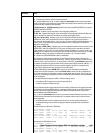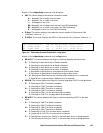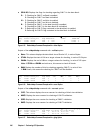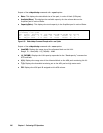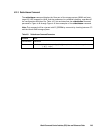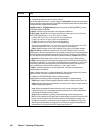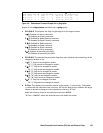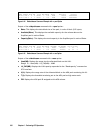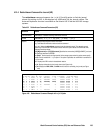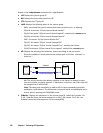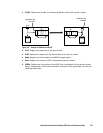
250 Chapter 4 Performing CCI Operations
Parameter Value
Options -h: Displays Help/Usage and version information.
-q: Terminates the interactive mode and exits the command.
-z or -zx (OpenVMS cannot use the -zx option): Makes the raidvchkscan command enter the interactive
mode. The -zx option guards performing of the HORCM in the interactive mode. When this option detects
a HORCM shut down, interactive mode terminates.
-I[H][M][instance#] or -I[TC][SI][instance#] Specifies the command as [HORC]/[HOMRCF], and used
for specifying instance# of HORCM.
-g <group>: Specifies a group name written in the configuration definition file.
-p <port> [hgrp]: Specifies the port ID of the port to be scanned. Valid ports are CL1-A to CL1-R and
CL2-A to CL2-R (excluding CL1-I, CL1-O, CL2-I, CL2-O). In addition:
For USP V/VM: CL3-a to CL3-r, or CLG-a to CLG-r for the expanded port
For USP: CL3-a to CL3-r, or CLG-a to CLG-r for the expanded port
For NSC: CL3-a to CL3-h, or CL8-a to CL8-h for the expanded port.
For 9900V: CL3-a to CL3-r, or CL4-a to CL4-r for the expanded port
The port is not case sensitive (e.g. CL1-A= cl1-a= CL1-a= cl1-A, CL3-a= CL3-A= cl3-a= cl3-A). This
option must be specified if “-find” or “-pd <raw_device>“option will not be specified.
[hgrp] is specified to display only the LDEVs mapped to a host group on a port (9900V and later).
-pd[g] <raw_device>: Specifies the raw device name. This option finds Seq# and port_name of the
storage system to which the specified device can be connected, and scans the port of the storage system
which corresponds with the unit ID that searches the unit ID from Seq#. This option must be specified if
the “-find” option will not be specified. If this option is specified, the following -s <Seq#> option is invalid.
-pdg (9900V and later): Shows a LUN on the host view by finding a host group (9900V and later).
-s <Seq#>: Used to specify the Seq# (serial#) of the storage system when this option cannot specify the
unit ID which is contained for “-p <port>“ option. This option scans the port specified by “-p <port>“ option
of the storage system which corresponds with the unit ID that searches the unit ID from Seq#. If this
option is specified, then the unit ID which is contained in “-p <port>“ option is invalid.
-t <target>: Specifies a target ID (0 to 15) of the specified port. If this option is not specified, the
command applies to all target IDs.
-l <lun>: Specifies a LUN (0 to 7) of the specified target ID. If this option is not specified, the command
applies to all LUNs. If this option is specified, the TID must also be specified.
-fx: Displays the LDEV/STLBA/ENLBA number in hexadecimal notation.
-v [op]: Specifies the following operation that displays each parameter for validation checking:
cflag: Displays all flags for checking regarding data block validation for target vols (see Figure 4.40).
offset: Dis
plays the range setting for data block size of Oracle I/O and a region on a target volume for
validation checking (see Figure 4.41).
errcnt: Dis
plays the statistical information counted as an error for each checking on the target
volumes (see Figure 4.42). Each statistical information counted as an error will be cleared when the
individual flag for validation checking is disabled.
gflag: Displays the parameter for guarding on the specified target volumes (see Figure 4.43).
pool: T
his option displays the pool capacity and the usable capacity for the pool ID to which the LDEV
belongs. This will be needed to help the decision whether the restore operation is possible or not,
because the pool capacity is consumed by the restore operation of the SnapShot (see Figure 4.44).
aou: Dis
plays the LUN capacity and usage rate for only HDP volume mapped to the specified port,
and displays the ID of the pool to which LDEV belongs (see Figure 4.45).




